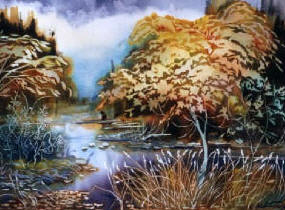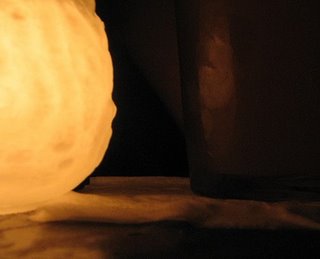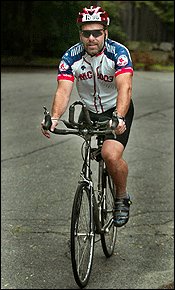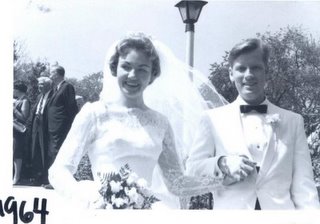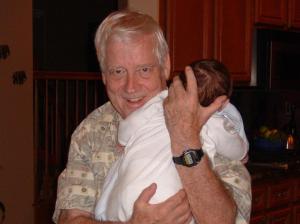Cover story for Spring 2006 Issue of LuxEsto, Kalamazoo College alumni magazine.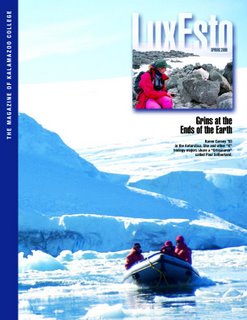
By Zinta Aistars
Paul Sotherland leans forward in his chair, and grins. No ordinary grin, mind you. This is the kind of grin that splits a face into bright light from ear to ear.
"Did you ever get that feeling" Paul says, "like something grabbing at the back of your head, or that tingling between your shoulder blades that grows out to your fingertips? That feeling when you first glimpse a fascinating set of data, a graph, or a new idea that you immediately know is significant in some way?"
If you were a biology student of Paul Sotherland, the answer is yes, you learned that feeling from Paul during experiences prefaced by the words “just for grins.” To honor their professor, and the miracle of his Just-for-Grins mantra, 14 graduates of Paul Sotherland’s science classes made the trek to Kalamazoo from various points across the country last November for a scientific symposium appropriately titled “Just for Grins.” Michael Finkler ‘91, Aaron Bommarito ‘97, Markus Boos ‘00, Sarah Bouchard ‘95, Karen Carney ‘93, Tara Darcy-Hall ‘97, Edward Dzialowksi ‘93, Tess Killpack ‘06, David Marcinek ‘93, Timothy Muir ‘03, Mairi Noverr ‘96, Wendy Reed ‘92, Brock Selbo ‘06, and Jeffrey Wilson ‘91 had felt that feeling, that tingling, that grab at the back of the head, and grinned for the sheer fun of pursuing their bliss in their newfound professions. They wanted their professor to know that.
Paul Sotherland has been teaching at Kalamazoo since 1985. The associate professor of biology and current chair of the biology department, received the Florence J. Lucasse Lectureship for Excellence in Teaching (1997-98), and the first Outstanding First-Year Student Advocate Award (2004). He teaches biology and a love for nurturing a life of the mind.
"The idea for a symposium came to me a year ago," says Mike Finkler, an associate professor of biology at Indiana University-Kokomo. I was driving home from the Indianapolis airport returning from a scientific conference which had also been attended by Wendy Reed and Tim Muir, also two of Paul's former students. I had been thinking about my upcoming sabbatical. I was planning to spend time at the University of North Texas where Ed Dzialowski, another of Paul's students, is an assistant professor. My mind turned to Paul and the incredible influence he had on my professional development both during and after my years at Kalamazoo College. 2005 would be his 20 year service anniversary, and it seemed fitting to put together an event to celebrate that milestone and to highlight the influence this one man has had on the development of so many excellent scholars."
With the help of biology department office coordinator, Mary Jane Holcomb, Mike was able to gather the contact information for a sizeable group of Paul's former students, and with surprisingly little effort, he convinced more than 14 of them to come back to Kalamazoo to pay their former professor their respects and, at the same time, connect with another generation of biology majors studying at Kalamazoo College. Each returnee agreed to give a presentation on their area of expertise in a daylong symposium. Topics ranged from printmaking and photography, nutritional ecology of freshwater turtles, maternal effects in the American Coot, locomotion in sauropod dinosaurs, allergic disease, and many others.
"The turnout was impressive," Mike says. "Eight of the speakers are instructors at other academic institutions, seven of them are professors, nine have doctoral degrees, and two are enrolled in graduate programs. It's easy to see how this postgraduate success ties in with Kalamazoo College's record of the proportion of its life sciences students earning doctorates."
That's a topic that gets Paul Sotherland especially excited. He attributes this success to the Kalamazoo Plan. "Some people say that the K-Plan is no longer unique because virtually all schools now offer internship programs, study abroad, and senior honors programs. But the fact that Kalamazoo College offers all these programs to nearly all our students, and that we build our on-campus curriculum around these experiences, makes our education unique and powerful."

While studies have shown that Kalamazoo College students do not consider themselves risk-takers upon matriculating, by commencement they often attribute becoming risk-takers—youth grown into adults who enjoy meeting challenges—because of the mix of rigorous academics accompanied by the experiential components of the Kalamazoo Plan.
Study abroad, says Paul, has proven especially transformative. "Adapting to new situations, learning to live with uncertainty, tolerating ambiguity, these are hallmark outcomes of the study abroad experience."
Paul is convinced that elements of the Kalamazoo Plan play a role in instilling or enhancing a love of learning that has translated into a positive trajectory of increasing numbers of postgraduate students emerging from Kalamazoo College.
“Compared to their peers,” he says, “on the average, Kalamazoo College graduates feel adequately prepared in their first year of graduate school. I think this reflects the fact that our students spend most of their junior year away while their peers at other schools are taking courses in their major. In the area of academic skills—research, reading, writing, and presentation—studies show that Kalamazoo graduates consider themselves better prepared than average.”
The symposium provided evidence of just how effective the Kalamazoo Plan can be. Each speaker concluded his/her presentation by acknowledging how interactions with Paul had given them direction and taught them far more than they expected.
Karen Carney, who now works on the Forestry Team of the U.S. Agency for International Development, says: “When I heard about Mike’s idea, I was thrilled. I thought it was a fantastic way to show how much Paul has meant to so many of us over the years. At the end of the day, I left the symposium with a real sense that we were all on the same team, all trying to build interesting, fun, and fulfilling lives. We had each found our own way of doing that, and I had this sense that we were all cheering each other on.”
The audience included alumni and current Kalamazoo College students as well. Connections were made, perhaps new fires lit, between graduates and undergraduates.
Karen says, “Having the opportunity to see our lives through the lens of an undergraduate was probably my favorite part. I totally got jazzed about helping them with the next steps in their careers and lives, and I also found an entirely new appreciation of my life choices and experiences. I also realized that I need to start listening to the advice I give out so freely. That is, don’t make choices for other people, don’t be afraid to try new paths, do take the initiative to get the job you want, and do realize that the process matters as much as the end goal. Lately, I have been obsessed with making my own career choices. The symposium reminded me: it’s all about learning, discovery, and fun. What a great gift!”
Paul calls this gift the “Fellowship in Learning.”
“Teaching is a noble enterprise,” he says. “There is an interaction between teacher and student that ignites a fire in both and is then spread to others. It is a teacher’s role to focus our attention not only on what we teach but whom we teach. I learned from my own teachers early on that science, biology in particular, is a human enterprise rather than just a pile of facts and theories to be memorized, understood, and enhanced. I learned that we can learn much by working with colleagues and students in this endeavor called ‘the study of life.’”
Markus Boos, a graduate student at the University of Chicago Medical Scientist Training Program, adds, “The great thing about Paul is that he is so accessible to students. This characteristic came up again and again at the symposium, but it can’t be overstated. As a first year, he was very intimidating to me. He was essentially my first college professor, and he seemed to know so much. Over the course of the quarter, I saw that he really cared whether we understood the material. When I look back from where I stand today as a medical student, I really see his influence on my life. My interest in medicine stems directly from my time in Paul’s classes, and my research requires me to apply, on a daily basis, principles that I learned in those classes. Even some of my pursuits outside the lab have been influenced by him. Together we organized the triathlon my senior year, and that got me running and biking a lot more (I was a swimmer in college); this past October I ran the Chicago marathon, and I don’t think I would ever have done that prior to the triathlon at Kalamazoo.”
“To teach at Kalamazoo College,” Paul says, “is to have an impact on a large number of world views, because we work very closely here with our students. We help them develop a clearer view of the world around them, and thereby have an impact on how they live their lives. When this is done with care, the results can be marvelous, and our indirect influence on the intellectual community can be enormous. All of us, our teachers and their teachers, our students and their students, are involved in this uniquely human enterprise of learning and teaching, and we are connected, one generation to the next, through relationships forged and ideas shared.”
It is Paul’s hope, and it appears a hope that is enthusiastically supported by his students, former as well as current, that the Just for Grins symposium will evolve into an annual event. If the first symposium was born of a wish to pay respect to a remarkable teacher, then the legacy would be to continue that exchange of ideas shared and relationships forged into future generations. When Paul speaks of a fellowship in learning, he travels back in Kalamazoo College time to President Allan Hoben (1922-1935) and Dr. Frances Diebold, professor emeritus of biology, recalling their influence and teaching.
“Through research being done by my colleague, Bob Stauffer in sociology and anthropology, I am learning about the early influences at the College and of the more recent effects of the Kalamazoo Plan,” he says. “Providing an academically challenging and supportive environment is a long-standing tradition at Kalamazoo, extending all the way back to the College’s founders. A fellowship in learning, President Hoben’s sage aphorism, captures this tradition and conveys a compelling message about who we are today and who we need to continue to be in the future. Are there ways to make this ‘Fellowship in Learning’ more palpable, bring it closer to the surface, to help guide our decisions and actions?”
A part of learning is continuing to ask questions. Scientists know that every new discovery and every enhancement made on a previous discovery begins with asking questions and testing the many possibilities.
Paul adds, “A college education is not acquired, or given, or purchased; it is built, piece by piece by apprentices working with, and learning from mentors. All of us—faculty, administrators, support staff, facilities management staff, trustees, and students— are in this endeavor together. And all of us ought to feel mighty good about our collective handiwork.”
Good enough to grin from ear to ear. That’s how the phrase was coined among those who have sat in Paul Sotherland’s classrooms. In the midst of serious scientific discussion, a sudden spark would appear in the professor’s eye. A grin would spread across his face. “Just for grins,” he would say, “let’s consider this possibility…”
And the class knew—they were about to embark on a new tangent, a new discovery, another adventure.
